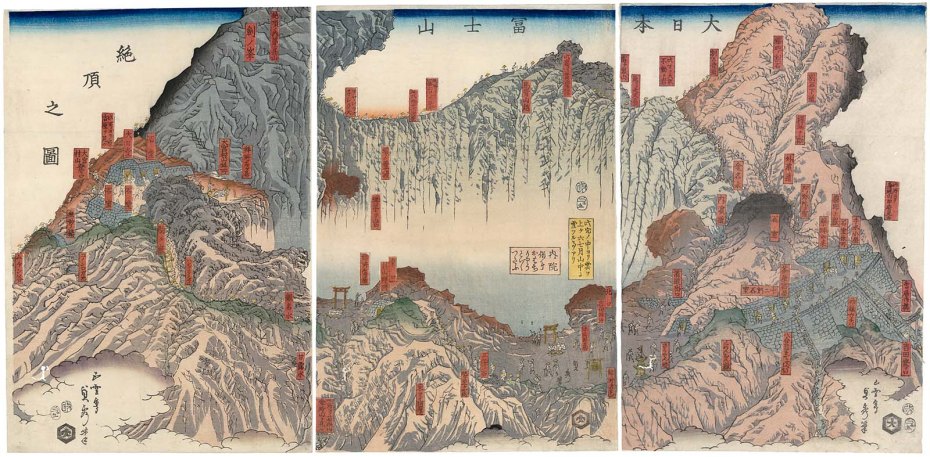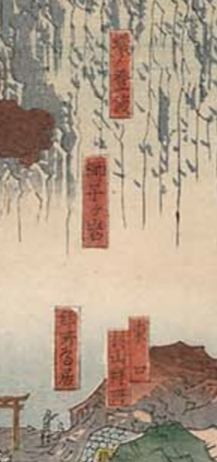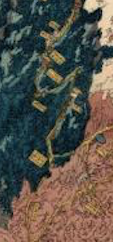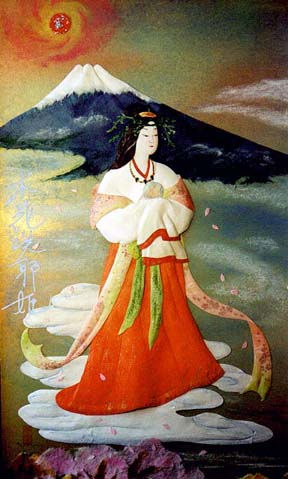Mount Fuji is the highest mountain in Japan. It is an active volcano and its height is an altitude of 3,776 meters. In June of 2013, it was designated as a UNESCO World Heritage property, under the name of ‘sacred place and source of artistic inspiration.’ As ‘the great object of universal devotion’ and ‘a source of artistic inspiration,’ Mount Fuji has been effecting to Japanese people’s lives, and their nature and culture. Therefore, it is drawn and created to maps by people. Fujisan no zu (富士山之圖) and Dai Nihon Fujisan Zetcho no zu (大日本富士山絶頂之圖) are the example of them.

Fujisan no zu (富士山之圖) – It means a ‘Map of Mount Fuji.’ This map was created by Sawaguchi Seio in 1848, which was Edo (or Tokugawa) period. It is a flat map and its dimensions are 91.4X96.5cm. However, it is a three-dimensional map at the same time, because the middle part of the map could be folded like a cone shape. It looks like real Mount Fuji when it is folded. Moreover, middle part of the left side of the map could be flipped. When it is flipped, there is another monochrome image. Overall, the map is showing an aerial view of Mount Fuji, and many religious features, such as pilgrims, figures of Buddha and monks, are indicated on the map.

Dai Nihon Fujisan Zetcho no zu (大日本富士山絶頂之圖) – It means a ‘Map of the summit of Mount Fuji.’ This map was created by Utagawa Sadahide in 1857, which was also Edo (or Tokugawa) period. It is a flat map and its dimensions are 36.0X76.0cm. It becomes a piece of completed map when three different parts are connected. Overall, the map is showing a panoramic view of crater of Mount Fuji. There are many religious features as well, such as torii (とりい), pilgrims and fortress with figures of Buddha.
As it could be seen above, there are many similarities between the two maps. In this writing, religious background of Mount Fuji would be discussed. At the same time, similarities of the two maps, such as spot signals (paths to the summit), pilgrims and no appearance of woman, would be analyzed based on the religious background.
Religious background
Mount Fuji has been considered as a sacred presence to Japanese. As the great object of universal devotion, it influenced Japanese’s outlook on nature. Japanese looked up the mountain and worshiped when it had volcanic activity. When the activity finished, the faith toward mountain and imported foreign Buddhism were combined, and the mountain became a place of asceticism. Especially people aimed to go up to the top and walk through the path with worshipping their gods. After few years, normal people who were called as believers climbed the mountain to follow the ascetics. In the middle of Edo period, after 17th century, Fujiko was appeared and spread. Fujiko was kind a lesson that taught a doctrine of Fuji religion. Many of Fujiko believers worshipped with walking the foot of the mountain and Oshi houses were reorganized to support believers who climbed the mountain. Oshi houses offered a place to sleep and some foods.
A start of Mount Fuji religion – A long time ago, people formed a community or performed religious ceremony at the foot of the mountain. Around 8-9th century, people thought the repeating volcanic activities were anger of a god of fire ‘Asamano Okami(浅間大神).’ To clam her down, people started to worship her from a distance. They looked top of the mountain and prayed, and it became a custom. Because of the custom, a place was created in order to worship from afar, like Yamamiya sengen shrine. After 800 years, Mount Fuji kept repeating great volcanic activities. To calm it down, some shrines were built again to pay people’s respects to the souls of Asamano Okami.
Fuji religion became popular – Around 12th century, Mount Fuji’s volcanic activities were calm down. Men of religion who were called as ascetics climbed the mountain to get some power from gods because they believed Mount Fuji was a land of asceticism. On the top of the mountain, a base of religion was built along the wall of craters. Around the craters, there were eight peaks and people thought they were eight floral leaves of lotus. People went on a pilgrimage to the eight peaks and it was called ‘Ohachimeguri.’ Matsudai Shonin, who was famous for climbing the mountain the most, built a temple, which was named ‘Dainichiji,’ on the top of the mountain. Moreover, he built ‘Murayama sengen’ shrine and it was a base for practice asceticism among men of religion. After 14th century, normal people could be pilgrims and climbed the mountain to follow the ascetics. From the entrance of the mountain, trails were reorganized and communities were formed for the climbers.
Prosperity of Fuji religion – In 17th century, Fujiko was created that came from ‘Hasegawa Gaku’ religion. Fujiko was a group of people who were full with faiths. They worshipped Mount Fuji as making a pilgrimage to scared places in a foot of the mountain such as Saiko, Shojiko and Oshino Hatkai. There were known as Gaku religion’s asceticism places. In 18th century, Fujiko gained explosive popularity among normal people. Therefore, the number of climbers increased and Oshi houses were developed. As living at the Oshi houses, monks led and took care the believers. In the middle of 19th century, path of pilgrimage in Mount Fuji was not the only one. It should not have to walk through by turns. It was made with many routes, which could be walk with various purposes of pilgrimage.
Similarities between the two maps
There are many religious features on the two maps. For example, on Fujisan no zu, there are many pilgrims, two monks and figures of Buddha. There are rooms and features of Buddha are located in the rooms. People go into the room and pray. Also, there are many writings on the map and one of them, the Waka poem that is in the middle of the map includes religious meaning. It says, “If you climb Mount Fuji, there is a scared meaning.” In addition, on Dai Nihon Fujisan Zetcho no zu, there are pilgrims who make a pilgrimage around the crater. Moreover,similar to Fujisan no zu, there are rooms and features of Buddha. People are praying to features of Buddha in fortresses. Furthermore, there are many toriis which look like a gate. They are usually located in front of shrine as a symbol of fortune. People believe that abusive things are changed to sacred through out the gate. They could be located in front of nature, then it means they worship the nature itself.


Spot signals (paths to the summit) – On the both maps, there are yellow or red spot signals and path to the summit. The spot signals indicate spots’ name or sacred places. Moreover, there are many paths to the summit at Mount Fuji, however, there are only important or popular paths are indicated on the maps.

Konohana no Sakuya hime and No admittance to woman – Mountain Fuji’s also had a mountain spirit and it was a woman. Her name was ‘Konohana no Sakuya hime (コノハナノサクヤビメ)’ and she was a god of blooming flowers. As a god of mountain Fuji, she was enshrined at Shingen shrine. However, one ironic thing is, women could not climb the mountain and they were banned even though the mountain spirit was woman. On the two maps, woman could not be found and all people on the maps are men.
Works cited
Hashimoto, Sadahide, 1807-1873, and Seiō Sawaguchi. Fujisan no Zu, Vancouver (B.C.) : University of British Columbia. Library, 1848.
Utagawa, Sadahide, 1807-1873. Dai Nihon Fujisan Zetchō no Zu, Vancouver (B.C.) : University of British Columbia. Library, 1857.
Bernstein, Andrew. “Whose Fuji? Religion, Region, and State in the Fight for a National Symbol.” Monumenta Nipponica, vol. 63, no. 1, 2008, pp. 51-99.
Irons, Edward A. “Fuji, Mt. (Fuji san).” Encyclopedia of Buddhism, edited by J. Gordon Melton, Facts on File, 2008, pp. 208-209. Facts on File Library of Religion and Mythology: Encyclopedia of World Religions. Gale Virtual Reference Library, go.galegroup.com/ps/i.do?p=GVRL&sw=w&u=ubcolumbia&v=2.1&id=GALE%7CCX4057500252&it=r&asid=4a4f3ebd714ee64b2600f5a915434628. Accessed 9 Apr. 2017.
Contributor: HyoEun
March 29, 2017
(Last update: April 14, 2017)

You must be logged in to post a comment.